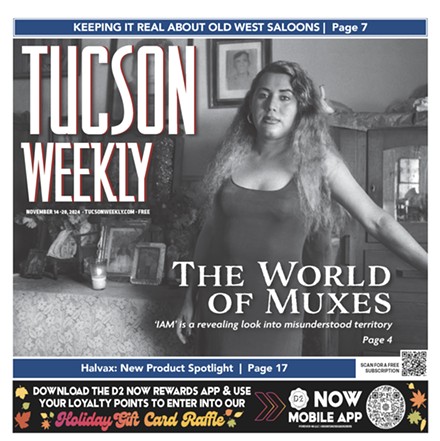The house at the northwest corner of Euclid Avenue and Sixth Street draws the attention of almost everyone who passes by.
On the east wall, foot-high, sky-blue lettering spells out, "Happiness Is Submission to God" on off-white stucco. The words are chipped and discolored in the places where graffiti has spattered them multiple times, changing "God" to "Godzilla" or "Godsmack," among other things.
The tenants who live there did not write the message. The words are remnants of the house's prior use as a mosque where local imam Dr. Rashad Khalifa lived and taught before he was murdered on Jan. 31, 1990.
The history of the house as a mosque starts with Khalifa's expulsion from the UA Islamic Center. Edip Yuksel, a lawyer and professor at Pima Community College who was close to Khalifa, estimates that Khalifa opened the mosque in the late 1970s.
"He was the vice president of the Islamic Center. When they discussed the issue of punishment for adultery and the stoning of women, he rejected it. He said, 'No, this had nothing to do with (the) Quran. It is borrowed from pagan and Jewish tradition,'" says Yuksel.
Khalifa's response was to found his own mosque based upon a form of Islam that was based solely on the Quran itself.
"He called the mosque Muslim Perspective. When I came in 1989, he decided to change the name of it to Submitters Perspective," says Yuksel.
Yuksel explained the Arabic equivalent to "submitter" or "submission" is not as harsh as the English term; it means a recognition that God is the one true God, and a commitment to only follow his words, not the words of man.
Khalifa emigrated from Egypt in 1959. He was an accomplished biochemist who at one point was the science adviser to Muammar al-Qadhafi, leader of Libya. During his study and translation of the Quran, he discovered that the number 19 carried a certain undeniable significance. He believed that the Quran has a mathematical consistency that is so complex that it proves the Quran, alone, is the word of god.
"In 1974, and for several years, he was celebrated within the Muslim community for this," says Yuksel.
His discovery led him to reject religious texts outside of the Quran, such as Hadith, or volumes of narrations attributed to Muhammad. His teachings angered many Muslim fundamentalists, who believed that his interpretation was Satanic. Yuksel compared the hatred aimed at Khalifa to that directed toward Salman Rushdie after he wrote The Satanic Verses.
Yuksel thinks that the rejection of Hadith and, later, the rejection of two lines of prayer within the Quran sealed the fate of Khalifa, who received death threats in different forms over the years.
"I remember he was killed (on) Jan. 31. When I came over in the morning, I saw police all around. He had a small gun with him when they found him, and he had borrowed it from a friend. People believe the killer was waiting for him inside," says Yuksel.
Khalifa's secretary found him in the kitchen of the mosque shortly after dawn; he had suffered several stab wounds. James Williams, an alleged member of paramilitary Muslim group Jamaat ul-Fuqra, was convicted of conspiracy to commit first-degree murder in 1993. Another suspect, Glen Cusford Francis, who fled the country under the pseudonym Benjamin Phillips, was arrested in Calgary, Alberta, Canada last year. Members of the Tucson Police Department were reportedly able to link Francis' DNA to forensic evidence from the scene.
Although Khalifa is gone, the United Submitters International remains in existence around the world. Some members of the original mosque, called Masjid Tucson, still live in Tucson and follow his teachings.
Lory Sierras joined the mosque in 1979. She had previously gone to the Islamic Center, but found it difficult to conform to the traditional religious roles of women as expressed at the Islamic Center. For her, United Submitters International and Khalifa's teachings provided a straightforward, strictly Quran-based approach to what she had always known.
Lydia Kelley, a follower of the USI since 1985, expressed similar sentiments. "I realized this is what I know; this is what I think; I always have. I just didn't know there was a name for it," says Kelley.
The house is part of the West University National Historic District. Jonathan Mabry, historic preservation officer for the city of Tucson, says that residents of the district can alter their homes, but changes have to meet certain guidelines.
"If you want to make significant changes, you have to go through review process to meet design guidelines. The design has to be historically sound and hold to the historical integrity of the building. You can build an addition, as long as the design is compatible, but it has to also be able to be differentiated from the original building," says Mabry.
The Happiness Is Submission to God house, located at 739 E. Sixth St., was constructed in 1919 and is attributed to Henry O. Jaastad, an architect who also designed Tucson High School and the Dunbar School. There are also small apartment buildings on the lot.
In the beginning days of the mosque, the east wall did not extend past the porch on the south side of the house, says current Masjid Tucson members Sierras, Kelley and Donna Erik. Instead of the words, there was a chimney. The addition was built to provide more room for the congregation to meet.







